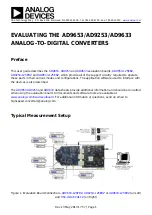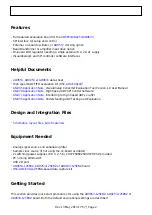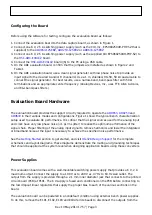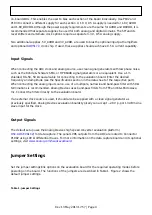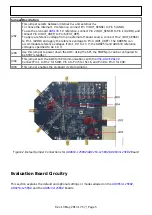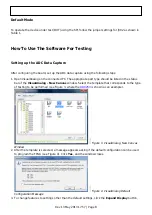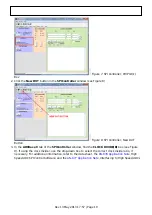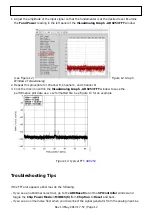
Rev 13 May 2013 17:57 | Page 6
Power
Plug the switching power supply into a wall outlet rated at 100 V ac to 240 V ac, 47 Hz to 63 Hz.
Connect the DC output connector to P101 on the evaluation board.
Analog Input
The four channel inputs on the evaluation board are set up for a double balun-coupled analog input
with a 50 Ω impedance. The default analog input configuration supports analog input frequencies of
up to ~200 MHz.
VREF
The default VREF configuration is to connect the SENSE pin to AGND for internal VREF operation. This
is done by connecting Pin 3 to Pin 5 on Header J202. An external reference voltage can be provided to
the
,
. Connecting Pin 2 to Pin 1 on Header J202 puts the ADC in a mode
where it requires a reference voltage from an external source. The external on-board 1.0 V reference
is provided by the
. This external reference can be connected to the ADC by connecting Pin 4
to Pin 6 on Header J202. Alternatively, if an external off-board reference is desired, connect Pin 2 to
Pin1 on Header J202 and apply the reference voltage directly to Pin 4 of Header J202. The AD9653 can
accommodate reference voltages from 1.0 V to 1.3 V; the AD9253 and AD9633 reference voltage is
specified to be 1.0 V.
RBIAS
RBIAS has a default setting of 10 kΩ (R205) to ground and is used to set the ADC core bias current.
Note that using a resistor value other than a 10 kΩ, 1% resistor for RBIAS may degrade the
performance of the device.
Clock
The default clock input circuit is derived from a simple transformer-coupled circuit using a high
bandwidth 1:1 impedance ratio transformer (T801/T802) that adds a low amount of jitter to the clock
path. The clock input is 50 Ω terminated and ac-coupled to handle single-ended sine wave types of
inputs. The transformer converts the single-ended input to a differential signal that is clipped by

